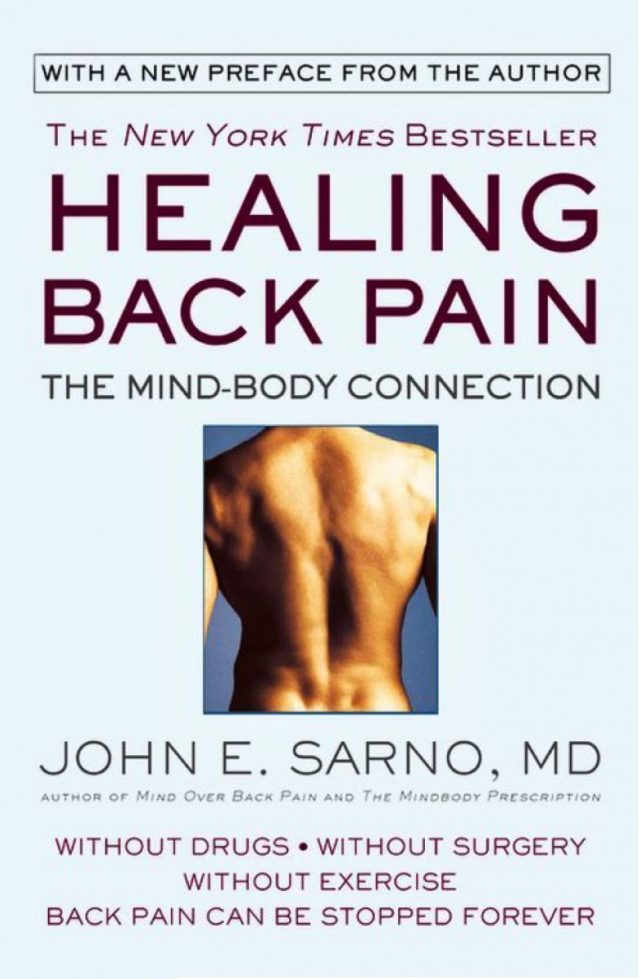I wrestled for some time with whether I should include this book as a recommendation on my site. On one hand, it’s a classic in the back pain category and many patients have found it useful. However, I am not one of them. I ultimately decided that I couldn’t in good conscience recommend a book that did nothing for me. But it is still worth discussing, and since some readers might find it useful I wrote this blog post.
I admit I wasn’t crazy about the concept of Sarno’s book when I first heard about it. Sarno’s basic idea is that many back-pain patients do not have any sort of structural problem behind their symptoms. Instead, they have sources of stress or repressed anger that cause tension, which reduced blood flow to tissues and restricts oxygen which causes pain. In his view, many conventional treatments are ineffective because they ignore the emotional issues at the start of the chain.
Sarno gained a minor celebrity status and cult following among patients, although he was largely shut out of the medical research community. After reading his book, I can understand both sides to some degree.
Sarno does come across as a genuinely caring and empathetic physician. My impression is that he was deeply concerned about his patients’ wellbeing, and was unusually willing to listen and see patients’ pain in the context of their daily life. Unlike many hucksters (including physicians) who offer miracle cures, Sarno didn’t seem particularly concerned with monetizing his insights. His book seemed to be a legitimate attempt at patient education rather than a marketing technique. Though I wasn’t converted to Sarno’s way of thinking, I believe he was writing and acting in good faith.
But to call Sarno’s book “scientific” would be a stretch. It’s one thing to say that stress can impact physical health, and that back pain cannot always be chalked up to a physical cause. But Sarno puts forth theories that are impossible to test, and seems to think that repressed emotions are responsible for any physical complaint with a non-obvious cause. He doesn’t go so far as to say repressed emotions cause cancer, but he does imply that one’s receptiveness to cancer treatment is strongly dependent on a patient’s beliefs and attitudes.
Sarno also leans heavily on Freud’s ideas of psychotherapy, which few psychologists or medical professionals still adhere to in their pure form. The idea that conditions as diverse as allergies, growing pains, fibromyalgia, tendonitis, and plantar fasciitis are all due to repressed emotions seems a little far-fetched.
Sarno reports that many patients experience pain when there is no obvious source of stress or distress. But if patients really dig deep, they will invariably uncover some deeply repressed source of anger or hurt. My question is, who wouldn’t be able to come up with some plausible emotional explanation for their complaint if they tried? Is it possible to survive to adulthood and still be entirely free of all sources of anger, resentment, or hurt? Aren’t negative emotions just a byproduct of being alive?
I was left thinking that TMS is a junk drawer diagnosis for difficult cases. It’s a convenient way to group tricky cases and slap a label on them. The “treatment” is awareness, and in some cases, psychotherapy.
However, my opinion is not the be-all end-all. Many patients credit Dr. Sarno for their recovery so I can’t completely dismiss his ideas. Until Dr. Sarno’s death in 2017, there was a website dedicated to posting thank you notes for Dr. Sarno and there is still an active wiki for TMS adherents.
If some people find Dr. Sarno’s ideas helpful then hey, more power to them. If it works, it works. But I personally didn’t find this book or Sarno’s ideas very helpful.

One thought on “Book Review: Healing Back Pain: The Mind-Body Connection by John E. Sarno”